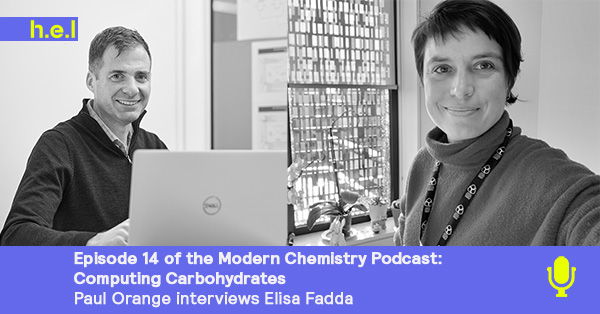Elisa Fadda
Computing carbohydrates

Episode 14 of the Modern Chemistry podcast is a deep discussion with Elisa Fadda about all things glycosylation, particularly how glycosylation of the SARS-CoV-2 spike protein plays an essential role in the infectivity of the COVID-19 causing virus. Since 2014, Elisa has been a lecturer in the Department of Chemistry at Maynooth University.
Our theme music is “Wholesome” by Kevin MacLeod
Music from Film Music
License: CC BY
Connect with me (Paul) on LinkedIn.
Elisa Fadda obtained her PhD in 2004 from the Department of Chemistry at the Université de Montréal under Professor Dennis R. Salahub. From May 2004 to May 2008, she worked as a post-doctoral fellow in Dr Régis Pomès’ group in Molecular Structure and Function at the Hospital for Sick Children (SickKids) Research Institute in Toronto. From June 2008 until May 2013, Elisa worked as a research associate and honorary research lecturer in Prof Robert J. Woods’ group in the School of Chemistry at NUI Galway. In 2013 she was awarded a Post-Graduate Certificate in Teaching and Learning in Higher Education from the Centre for Learning and Teaching (CELT) at NUI Galway. In August 2013, Elisa became an Assistant Lecturer in the Department of Chemistry at Maynooth University, taking on a Lecturer position in 2014.
Terms used during interview
- Quantum chemistry –The branch of chemistry that applies quantum mechanics to chemical systems, including electronic structure, molecular dynamics, and Schrödinger equations.
- Biophysics – And approach to science that applies methods typically used in physics to study biology and biological systems.
- Glycoproteins – Proteins that contain oligosaccharide chains (glycans) attached to amino acid side-chains via a covalent bond.
- Carbohydrates – Molecules (typically biological) composed of Carbon, Hydrogen, and Oxygen, typically with a 2:1 Hydrogen: Oxygen atom ratio.
- Glycan (or polysaccharide) – Compounds made of many monosaccharide subunits, linked via a glycoside bond.
- N-Glycans – Glycans attached to a protein at an Asparagine residue via an N-glycosidic bond.
- Sequon – A sequence of amino acids in a protein that serves as a carbohydrate-binding site. The carbohydrate is often an N-linked-Glycan.
- Asparagine, proline, serine, threonine. – Amino acids found naturally in biological proteins. Asparagine, serine, and threonine are required in specific combinations to form a sequon; proline must be absent from a sequon.
- Glycosaminoglycans or mucopolysaccharides- Long, linear glucans consisting of repeating disaccharide units – most commonly uronic acid and an amino sugar.
- Glycosylation – A reaction in which a carbohydrate molecule is attached to a functional group of another molecule (such as a hydroxyl). In biology, the term typically refers to the carbohydrate being attached to a protein molecule.
- Folded protein – Proteins have several levels of structure; secondary and tertiary (and arguably quaternary) levels of structure describe how the polypeptide chain forms into specific structures that typically confer functional properties.
- Cryo-EM – Cryogenic Electron Microscopy studies samples cooled to cryogenic temperatures (-153 oC or lower) while embedded in vitreous water.
- X-Ray crystallography – A technique that uses X-rays to determine crystal structures while studying X-ray diffraction patterns.
- NMR – Nuclear Magnetic Resonance subjects samples to strong magnetic fields and measures the resonance pattern of the nuclei. It is widely used to study the structure and dynamics of organic molecules.
- Spike proteins – More properly ‘Peplomers’ spike proteins are glycoproteins that project from the surface of a virus particle lipid bilayer and play an essential part in viral infectivity.
- Coronavirus – One of a group of related RNA viruses that cause respiratory tract infections in birds and mammals. These infections lead to diseases that can have mild effects or be lethal. The Covid-19 pandemic was caused by a coronavirus, the SARS-CoV-2 virus. The SARS-CoV-1 virus caused the 2002/4 SARS outbreak.
- HIV – The Human Immunodeficiency Virus is two species of lentivirus that, if left untreated, cause Acquired Immunodeficiency Syndrome (AIDS) in humans.
- Receptor – A protein embedded in a cell membrane that binds to a specific molecule or class of molecules. Once the target molecule is bound, there is typically an effect within the cell to trigger some form of biological process.
- (viral) Pathogenesis – The process by which disease progresses. Viral pathogenesis is specific to a disease caused by a virus.
- Computer node – Each computer in a connected cluster that are working together.
- GPUs – Graphics Processing Units are specific electronic circuits that rapidly address memory to output images to a display device. Their highly parallel structure makes them efficient at processing algorithms that process large data blocks in parallel.
- Glycoanalytics – Scientific study of glycosylated molecules, often biological in nature.
- Neuraminidase, or Sialidase, are enzymes that cut neuraminic acid’s glycosidic bonds. This action helps viruses move through the respiratory tract mucus and infect host cells.
The publication we refer to early in the discussion can be found here. For a complete list of Elisa’s publications, visit her group website. Alternatively, if you want to contact Elisa, you can find her on LinkedIn and Twitter.


